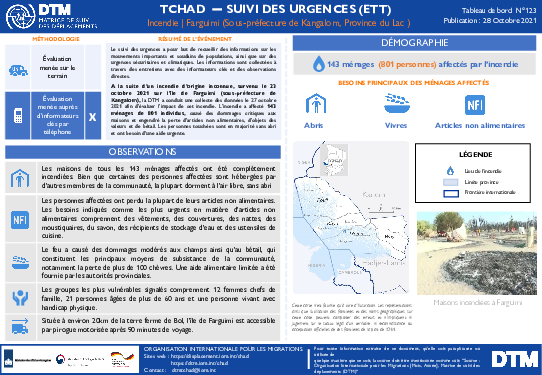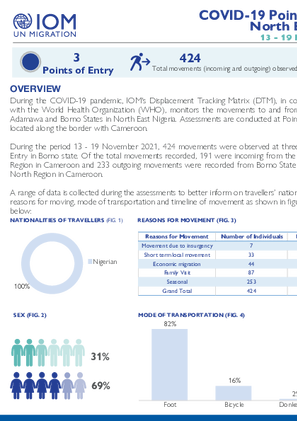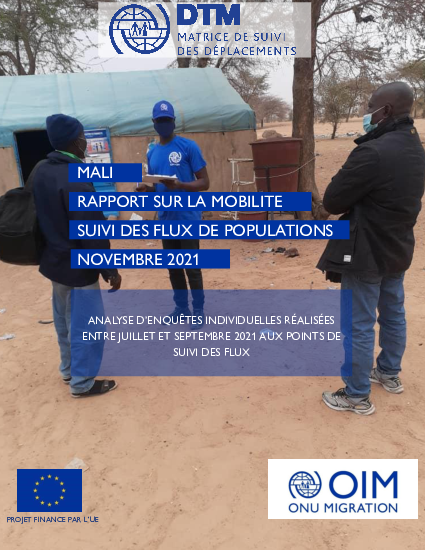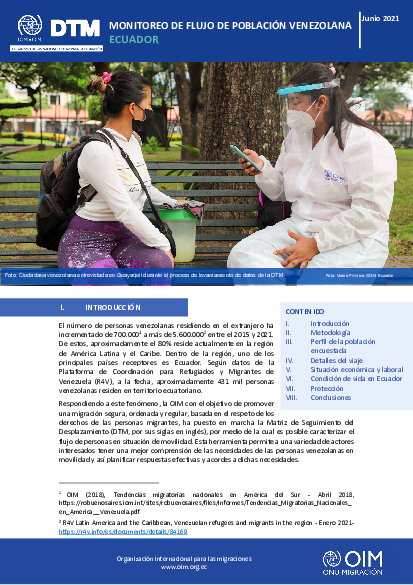-
Countries
-
Data and Analysis
-
Special Focus
-
Crisis Responses

Contact
DTM Tchad, dtmtchad@iom.int
Language
French
Location
Chad
Snapshot Date
Oct 23 2021
Activity
- Event Tracking
- Mobility Tracking
Le suivi des urgences a pour but de recueillir des informations sur les mouvements importants et soudains de populations, ainsi que sur des urgences sécuritaires et climatiques. Les informations sont collectées à travers des entretiens avec des informateurs clés et des observations directes. A la suite d’un incendie d’origine inconnue, survenu le 23 octobre 2021 sur l’île de Farguimi (sous-préfecture de Kangalom), la DTM a conduit une collecte des données le 27 octobre 2021 afin d’évaluer l’impact de cet incendie. L’incendie a affecté 143 ménages de 801 individus, causé des dommages critiques aux maisons et engendré la perte d'articles non alimentaires, d’objets des valeurs et de bétail.

Contact
Regional Office Dakar, RODakar-DataResearch@iom.int
Language
French
Location
Burkina Faso
Period Covered
Sep 01 2021
Sep 30 2021
Activity
- Flow Monitoring
Le suivi des flux, qui est mis en œuvre en étroite collaboration avec les autorités et des partenaires nationaux et locaux, est composé de deux outils: l’enregistrement des flux (Flow Monitoring Registry, FMR), qui recueille des données clés sur l’ampleur, la provenance, la destination et les modalités des flux de mobilité, et les enquêtes individuelles (Flow Monitoring Survey, FMS), conduites auprès des voyageurs afin d’obtenir des informations sur les profils, parcours migratoires, et intentions des migrants.
Au Burkina Faso, la DTM recueille des données au niveau de 4 Points de suivi des flux (Flow Monitoring Points, FMP), répartis dans 4 régions afin d’obtenir une meilleure compréhension de l’ampleur, des tendances, des caractéristiques socio-démographiques et des parcours des flux de voyageurs traversant ces différents points.
Ce rapport présente les données recueillies dans le cadre des activités d’enregistrement des flux durant le mois de Septembre 2021.

Contact
DTM Nigeria, AllUsersInDTMNigeria@iom.int
Language
English
Location
Nigeria
Period Covered
Nov 15 2021
Nov 21 2021
Activity
- Event Tracking
- Mobility Tracking
Nigeria's North Central and North West Zones are afflicted with a multidimensional crisis that is rooted in long-standing tensions between ethnic and religious groups and involves attacks by criminal groups and banditry/hirabah (such as kidnapping and grand larceny along major highways). The crisis has accelerated during the past years because of the intensification of attacks and has resulted in widespread displacement across the region.
Between 15 and 21 November 2021, armed clashes between herdsmen and farmers; and bandits and local communities have led to new waves of population displacement. Following these events, rapid assessments were conducted by DTM (Displacement Tracking Matrix) field staff with the purpose of informing the humanitarian community and government partners, and enable targeted response. Flash reports utilise direct observation and a broad network of key informants to gather representative data and collect information on the number, profile and immediate needs of affected populations.
During the assessment period, the DTM identified an estimated number of 633 individuals who were displaced to neigbouring villages in the LGAs Sabon Birni in Sokoto State and Anka in Zamfara State. A total of 21 casualties were reported, including 13 injuries and 8 fatalities.

Contact
DTM Nigeria, AllUsersInDTMNigeria@iom.int
Language
English
Location
Nigeria
Period Covered
Nov 13 2021
Nov 19 2021
Activity
- Mobility Tracking
- Baseline Assessment
- Points of Entry (PoE)
During the COVID-19 pandemic, IOM's Displacement Tracking Matrix (DTM), in collaboration with the World Health Organization (WHO), monitors the movements to and from Nigeria's Adamawa and Borno States in North East Nigeria. Assessments are conducted at Points of Entry located along the border with Cameroon.
During the period 13 - 19 November 2021, 424 movements were observed at three Points of Entry in Borno state. Of the total movements recorded, 191 were incoming from the Far North Region in Cameroon and 233 outgoing movements were recorded from Borno State to the Far North Region in Cameroon.
A range of data is collected during the assessments to better inform on travellers’ nationalities, sex, reasons for moving, mode of transportation and timeline of movement as shown in figures 1 to 4

Contact
REMAPBD@iom.int
Language
English
Location
Bangladesh
Period Covered
Mar 01 2021
Apr 30 2021
Activity
- Flow Monitoring
- Migrants presence
According to available data from the Displacement Tracking Matrix (DTM) in Libya compiled in the following snapshot by the DTM REMAP project, funded by the European Union (EU), 20,123 Bangladeshi nationals were identified through DTM’s baseline Mobility Tracking module in Libya between March and April 2021. Mobility Tracking in Libya gathers data through key informant interviews at both the municipality and community level on a bi-monthly basis. All 100 municipalities were assessed, and 1,944 key informant interviews were carried out during the data collection period. Of the total migrants identified by key informants in the country in March and April 2021, Bangladeshi migrants made up only three per cent of total migrants in the country; however, Bangladeshi nationals accounted for 40 per cent of all migrants, including refugees, from South Asia and the Middle East. Ninety-four per cent of Bangladeshi migrants used air travel as their means of transportation to Libya. In addition, the average cost of their migration was 3,919 USD2. Sixty-seven percent of Bangladeshi migrants were identified in western Libya, with Tripoli having the highest (28%) concentration of Bangladeshi nationals, followed by Ejdabia (10%) and Misrata (10%).

Contact
REMAPBD@iom.int
Language
English
Location
Bangladesh
Period Covered
Mar 01 2020
Apr 30 2020
Activity
- Flow Monitoring
- Migrants presence
According to available data from the Displacement Tracking Matrix (DTM) in Libya compiled in the following snapshot by the DTM REMAP project, funded by the European Union (EU), 19,710 Bangladeshi nationals were identified through DTM’s baseline Mobility Tracking module in Libya between March and April 2020. Mobility Tracking in Libya gathers data through key informant interviews at both the municipality and community level on a bi-monthly basis. All 100 municipalities were assessed, and 2,170 key informant interviews were carried out during the data collection period. Of the total migrants identified by key informants in the country in March and April 2020, Bangladeshi migrants made up only three per cent of total migrants in the country; however, Bangladeshi nationals accounted for 43 per cent of all migrants, including refugees, from South Asia and the Middle East. Ninety-seven per cent of Bangladeshi migrants used air travel as their means of transportation to Libya. In addition, the average cost of their migration was 3,395 USD2. Seventy-four percent of Bangladeshi migrants were identified in western Libya, with Tripoli having the highest (33%) concentration of Bangladeshi nationals, followed by Misrata (11%) and Ejdabia (11%)
Contact
revina@iom.int
Location
Zimbabwe
Activity
- Mobility Tracking
- Baseline Assessment
Period Covered
Oct 27 2020 -Nov 10 2020
A baseline assessment is a sub-component of mobility tracking. It aims to collect data on IDP, migrant or returnee population presence in a defined administrative area of the country.
Population Groups
Survey Methodology
Unit of Analysis Or Observation
Type of Survey or Assessment
Keywords
Geographical Scope
Administrative boundaries with available data
The current dataset covers the following administrative boundaries
Contact
revina@iom.int
Location
Zimbabwe
Activity
- Mobility Tracking
- Baseline Assessment
Period Covered
Feb 24 2021 -Mar 05 2021
A baseline assessment is a sub-component of mobility tracking. It aims to collect data on IDP, migrant or returnee population presence in a defined administrative area of the country.
Population Groups
Survey Methodology
Unit of Analysis Or Observation
Type of Survey or Assessment
Keywords
Geographical Scope
Administrative boundaries with available data
The current dataset covers the following administrative boundaries

Contact
DTM Mali, DTMMali@iom.int
Language
French
Location
Mali
Period Covered
Jul 01 2021
Sep 30 2021
Activity
- Survey
- Flow Monitoring Survey
- Flow Monitoring
Le rapport présente les principaux résultats des enquêtes individuelles effectuées par la DTM auprès de migrants transitant par les points de suivi de flux (FMP) du Mali au cours du troisième trimestre de l’année 2021.
Les résultats des enquêtes FMS réalisées témoignent du fait que le Mali soit l’une des principales routes empruntées par les migrants en Afrique de l’Ouest. En effet, la diversité des nationalités observées (20 nationalités), des routes empruntées, des pays de provenance et de destination, démontrent la place prépondérante qu’occupe le Mali dans les mobilités en Afrique de l’Ouest et du Centre.
Il ressort par ailleurs de ces analyses que les migrants sont majoritairement des hommes célibataires, des jeunes âgés entre 20 et 30 ans voyageant principalement pour des raisons économiques. Spécifiquement, ils sont à la recherche d’opportunités de travail soit à l’intérieur de la région, soit en Afrique du Nord ou espérant rejoindre l’Europe.

Contact
IOM Ecuador, iomecdtm@iom.int
Language
Spanish
Location
Ecuador
Period Covered
Jun 01 2021
Jun 27 2021
Activity
- Survey
- Flow Monitoring Survey
- Flow Monitoring
El número de personas venezolanas residiendo en el extranjero ha incrementado de 700.0001 a más de 5.600.0002 entre el 2015 y 2021. De estos, aproximadamente el 80% reside actualmente en la región de América Latina y el Caribe. Dentro de la región, uno de los principales países receptores es Ecuador. Según datos de la Plataforma de Coordinación para Refugiados y Migrantes de Venezuela (R4V), a la fecha, aproximadamente 431 mil personas venezolanas residen en territorio ecuatoriano.
Respondiendo a este fenómeno, la OIM con el objetivo de promover una migración segura, ordenada y regular, basada en el respeto de los derechos de las personas migrantes, ha puesto en marcha la Matriz de Seguimiento del Desplazamiento (DTM, por sus siglas en inglés), por medio de la cual es posible caracterizar el flujo de personas en situación de movilidad. Esta herramienta permite a una variedad de actores interesados tener una mejor comprensión de las necesidades de las personas venezolanas en movilidad y así planificar respuestas efectivas y acordes a dichas necesidades.
